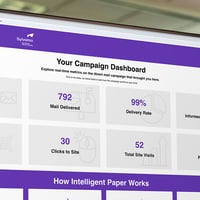Digital Dish: August 2020
Each dish will feature a new nugget to chew on and fuel your digital cravings. This month, John Crumbaugh, Product Manager for ColorPRO Papers in HP's Media and Supplies Division, returns as host to provide tips on selecting the "right" paper for your print work on inkjet production presses. Printers who produce the same jobs day in and day out on a small number of papers face a much different situation than printers that must cope with a wide variety of jobs on a wide variety of papers, many of which are requested for just-in-time delivery.
Printers who use only one or two papers have the opportunity to test a range of papers to narrow down what is best for their work. This level of optimization can increase production and profitability significantly. Printers with a range of paper needs will expend more effort and time to optimize, but stand to benefit measurably. Although the scale of the problem is larger in a situation with more variety of jobs and paper needs, the issue of selecting the "right" paper is present in both scenarios.
WHAT'S THE "RIGHT" PAPER?
Papers respond differently on inkjet presses compared to offset presses, and the number of choices within a given grade is also different. In the case of inkjet, it is important to look at more than just the quality of output, but also look at how the paper ran during and after printing. On the back end of the press and finishing lines, printers should look at paper and consider the:
- Speed through the press
- Finishing efficiencies
- Latitude on press
- Amount of ink used
- Overall job quality
Four of the considerations above are tied to the cost to produce a job, while one is tied to quality. Using the "right" paper doesn't necessarily mean using the lowest priced option. Using the right paper ensures that the job being produced meets the customer's requirements for quality in the most cost-efficient way possible. Judging a paper solely on its per ton price is like judging a book by the cover alone. Taking time to fully understand what a paper can do and what the actual production costs are will enable you to choose the right paper. Let's dive into this further!
HOT OFF THE WEB-FED PRESS
Paper choice can impact the speed at which an inkjet press can produce work that meets the customers' expectations and needs. Basic common sense applies: the faster the press runs, the more jobs that can be produced on that asset; however, this item is often overlooked by the paper buyer, resulting in a press running more slowly due to paper selection.
Although finishing lines will differ across inkjet presses, many of them employ finishing automation for efficiency of production. For optimized throughput, the chosen paper also needs to finish well, or the bottleneck moves from the press to the finishing line.
The latitude of a given paper is another important cost component of inkjet printing. Ideally, the paper should be fully fit for use in a range of coverage, speed and quality scenarios, making it easier to run jobs and gang work. Printing on the edge of usability leads to waste and increased production costs. Papers with latitude allow for flexibility on press and are not impacted by the normal variability of press conditions, roll tolerances, or changes in coverage, all of which ensure operators spend their valuable time producing sell-able work.
CONSIDER THE QUALITY
iDifferent papers of the same grade/type can either use more or less ink to achieve the same visual results. Inkjet inks are typically more costly than offset inks, so selecting a paper that minimizes the amount of ink used has multiple benefits. Using less aqueous inkjet ink allows for less drying, less water to absorb and less money spent on ink. Inkjet treated papers like Accent® Opaque and Williamsburg Offset with ColorPRO Technology are examples of papers designed to maximize the inkjet pigment inks and give optimal output on a range of inkjet presses.
Selecting papers isn't difficult, but it does require that papers be tested through comprehensive trialing processes both on press and through finishing to determine how effective they are in managing the four cost components described today. In summary, the "right" paper for an inkjet press is one that has a range of latitude and produces the work cost effectively with the least amount of operator effort.
SYLVAMO'S DIGITAL INKJET PORTFOLIO
Inkjet technology is ever evolving and improving, so keeping an eye on the overall marketplace is key to full optimization in this environment. Thank you again to John and HP Inc.'s ColorPRO Technology program for ensuring PSPs and partners can take full advantage of improvements in overall inkjet technology by continually working to improve HP's products or add new ones to the market. For a complete list of Sylvamo's digital inkjet product line, visit our website.






